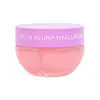What's inside
What's inside
 Key Ingredients
Key Ingredients

 Benefits
Benefits

 Concerns
Concerns

 Ingredients Side-by-side
Ingredients Side-by-side

Hydrogenated Polyisobutene
EmollientDiisostearyl Dimer Dilinoleate
EmollientPhytosteryl/Octyldodecyl Lauroyl Glutamate
Skin ConditioningEthylene/Propylene/Styrene Copolymer
Menthone Glycerin Acetal
RefreshingPrunus Armeniaca Kernel Oil
MaskingHelianthus Annuus Seed Oil
EmollientCarica Papaya Seed Oil
HumectantCitrullus Lanatus Seed Oil
EmollientCocos Nucifera Oil
MaskingLinum Usitatissimum Seed Oil
PerfumingPrunus Domestica Seed Oil
Skin ConditioningRibes Nigrum Seed Oil
EmollientRosa Canina Fruit Oil
EmollientRubus Fruticosus Seed
Skin ConditioningVitis Vinifera Seed Oil
EmollientPassiflora Edulis Seed Oil
EmollientSalvia Hispanica Seed Oil
MoisturisingRicinus Communis Seed Oil
MaskingSodium Hyaluronate
HumectantHydrogenated Castor Oil
EmollientCitrullus Lanatus Fruit Extract
Skin ConditioningCitrus Limon Fruit Extract
MaskingFragaria Vesca Fruit Extract
AstringentPrunus Persica Fruit Extract
AbrasiveTocopheryl Acetate
AntioxidantVaccinium Angustifolium Fruit Extract
Skin ProtectingVaccinium Macrocarpon Fruit Extract
AstringentGlyceryl Caprylate
EmollientEthyl Vanillin
MaskingButylene/Ethylene/Styrene Copolymer
Glyceryl Behenate/Eicosadioate
EmollientPentaerythrityl Tetra-Di-T-Butyl Hydroxyhydrocinnamate
AntioxidantTocopherol
AntioxidantCI 77891
Cosmetic ColorantCI 15850
Cosmetic ColorantIron Oxides
CI 19140
Cosmetic ColorantCI 42090
Cosmetic ColorantCI 45410
Cosmetic ColorantCI 17200
Cosmetic ColorantHydrogenated Polyisobutene, Diisostearyl Dimer Dilinoleate, Phytosteryl/Octyldodecyl Lauroyl Glutamate, Ethylene/Propylene/Styrene Copolymer, Menthone Glycerin Acetal, Prunus Armeniaca Kernel Oil, Helianthus Annuus Seed Oil, Carica Papaya Seed Oil, Citrullus Lanatus Seed Oil, Cocos Nucifera Oil, Linum Usitatissimum Seed Oil, Prunus Domestica Seed Oil, Ribes Nigrum Seed Oil, Rosa Canina Fruit Oil, Rubus Fruticosus Seed, Vitis Vinifera Seed Oil, Passiflora Edulis Seed Oil, Salvia Hispanica Seed Oil, Ricinus Communis Seed Oil, Sodium Hyaluronate, Hydrogenated Castor Oil, Citrullus Lanatus Fruit Extract, Citrus Limon Fruit Extract, Fragaria Vesca Fruit Extract, Prunus Persica Fruit Extract, Tocopheryl Acetate, Vaccinium Angustifolium Fruit Extract, Vaccinium Macrocarpon Fruit Extract, Glyceryl Caprylate, Ethyl Vanillin, Butylene/Ethylene/Styrene Copolymer, Glyceryl Behenate/Eicosadioate, Pentaerythrityl Tetra-Di-T-Butyl Hydroxyhydrocinnamate, Tocopherol, CI 77891, CI 15850, Iron Oxides, CI 19140, CI 42090, CI 45410, CI 17200
Hydrogenated Polyisobutene
EmollientPolybutene
Bis-Behenyl/Isostearyl/Phytosteryl Dimer Dilinoleyl Dimer Dilinoleate
EmollientDiisostearyl Malate
EmollientSynthetic Wax
AbrasiveEthylene/Propylene/Styrene Copolymer
Sucrose Tetrastearate Triacetate
EmollientEuphorbia Cerifera Cera
AstringentTribehenin
EmollientTrihydroxystearin
Skin ConditioningSodium Hyaluronate
HumectantRubus Idaeus Leaf Extract
Skin ConditioningTerminalia Ferdinandiana Fruit Extract
AntioxidantPrunus Salicina Fruit Extract
AntioxidantGlycerin
HumectantTocopherol
AntioxidantGardenia Florida Fruit Extract
Skin ConditioningPentaerythrityl Tetra-Di-T-Butyl Hydroxyhydrocinnamate
AntioxidantRebaudioside A
Skin ConditioningCaprylic/Capric Triglyceride
MaskingPolyglyceryl-3 Polyricinoleate
EmulsifyingPolyglyceryl-2 Triisostearate
EmulsifyingPolyglyceryl-2 Diisostearate
EmulsifyingButylene/Ethylene/Styrene Copolymer
Dehydroacetic Acid
PreservativeWater
Skin ConditioningAroma
Hydrogenated Polyisobutene, Polybutene, Bis-Behenyl/Isostearyl/Phytosteryl Dimer Dilinoleyl Dimer Dilinoleate, Diisostearyl Malate, Synthetic Wax, Ethylene/Propylene/Styrene Copolymer, Sucrose Tetrastearate Triacetate, Euphorbia Cerifera Cera, Tribehenin, Trihydroxystearin, Sodium Hyaluronate, Rubus Idaeus Leaf Extract, Terminalia Ferdinandiana Fruit Extract, Prunus Salicina Fruit Extract, Glycerin, Tocopherol, Gardenia Florida Fruit Extract, Pentaerythrityl Tetra-Di-T-Butyl Hydroxyhydrocinnamate, Rebaudioside A, Caprylic/Capric Triglyceride, Polyglyceryl-3 Polyricinoleate, Polyglyceryl-2 Triisostearate, Polyglyceryl-2 Diisostearate, Butylene/Ethylene/Styrene Copolymer, Dehydroacetic Acid, Water, Aroma
 Reviews
Reviews

Ingredients Explained
These ingredients are found in both products.
Ingredients higher up in an ingredient list are typically present in a larger amount.
We don't have a description for Butylene/Ethylene/Styrene Copolymer yet.
We don't have a description for Ethylene/Propylene/Styrene Copolymer yet.
Hydrogenated Polyisobutene is a synthetic polymer. Polymers are compounds with high molecular weight. Hydrogenated Polyisobutene is an emollient and texture enhancer.
In one study, Hydrogenated Polyisobutene showed better skin hydration levels than Caprylic/Capric Triglyceride. As an emollient, it helps keep your skin soft and hydrated by trapping moisture in.
Hydrogenated Polyisobutene is often used as a mineral oil replacement.
Learn more about Hydrogenated PolyisobutenePentaerythrityl Tetra-Di-T-Butyl Hydroxyhydrocinnamate (long name, huh?) is a synthetic antioxidant.
It is used to help stabilize other antioxidants or prevent the color from changing in a product.
As an antioxidant, it helps fight free-radical molecules. Free-radical molecules are capable of damaging our cells and other genetic material. Thus, antioxidants may reduce the signs of aging.
This ingredient is oil-soluble.
Learn more about Pentaerythrityl Tetra-Di-T-Butyl HydroxyhydrocinnamateSodium Hyaluronate is hyaluronic acid's salt form. It is commonly derived from the sodium salt of hyaluronic acid.
Like hyaluronic acid, it is great at holding water and acts as a humectant. This makes it a great skin hydrating ingredient.
Sodium Hyaluronate is naturally occurring in our bodies and is mostly found in eye fluid and joints.
These are some other common types of Hyaluronic Acid:
Learn more about Sodium HyaluronateTocopherol (also known as Vitamin E) is a common antioxidant used to help protect the skin from free-radicals and strengthen the skin barrier. It's also fat soluble - this means our skin is great at absorbing it.
Vitamin E also helps keep your natural skin lipids healthy. Your lipid skin barrier naturally consists of lipids, ceramides, and fatty acids. Vitamin E offers extra protection for your skin’s lipid barrier, keeping your skin healthy and nourished.
Another benefit is a bit of UV protection. Vitamin E helps reduce the damage caused by UVB rays. (It should not replace your sunscreen). Combining it with Vitamin C can decrease sunburned cells and hyperpigmentation after UV exposure.
You might have noticed Vitamin E + C often paired together. This is because it is great at stabilizing Vitamin C. Using the two together helps increase the effectiveness of both ingredients.
There are often claims that Vitamin E can reduce/prevent scarring, but these claims haven't been confirmed by scientific research.
Learn more about Tocopherol